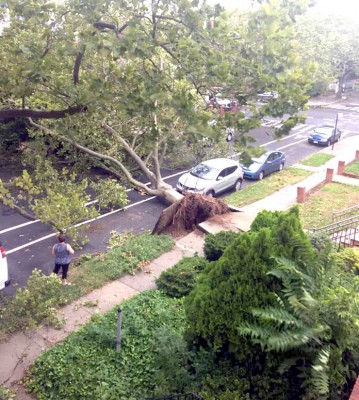

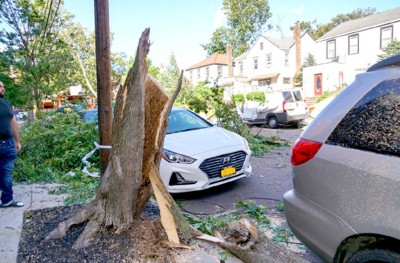
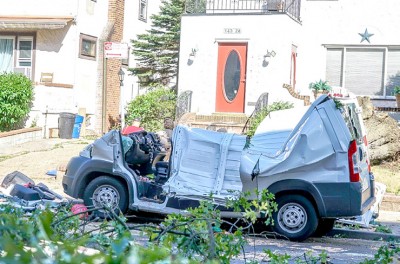
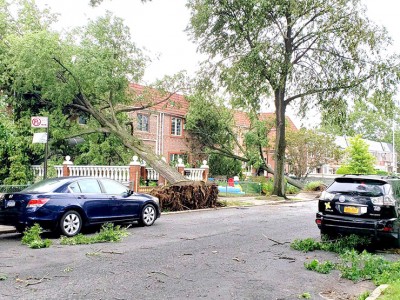
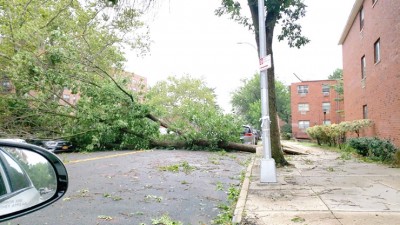

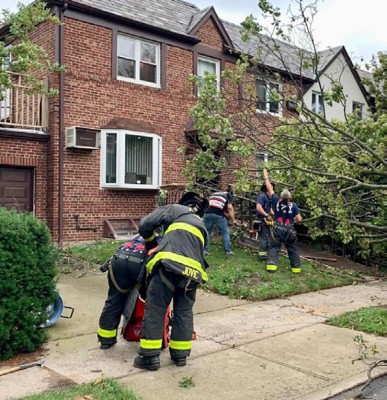

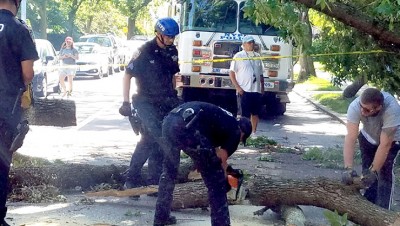
The aftermath of Tropical Storm Isaias was felt throughout New York City last Tuesday, August 4th. Twigs, branches, and other debris lay scattered across city streets. Larger tree limbs of decimated oaks, Norway maples, and catalpas were sheared off longstanding trees, landing atop parked cars and against homes from tree-toppling winds; over 2,000 trees fell throughout the city, and over 210,000 families were still without electricity as nightfall arrived.
Heeding government warnings in the hours leading up to the storm, many homeowners took time to secure loose items in or on their yards, porches, and decks. Store owners with outdoor dining accommodations disassembled tents, guardrails, and planters to avoid large-scale damage.
Around 1 p.m., winds of 65 mph were recorded in New York City, while Long Island winds reached 109 mph. The city announced closures of construction projects, and the Queens Public Library system announced a suspension of to-go operations. Elevated subway service was halted along with the operations of LIRR, Metro North, NJ Transit, and all local ferry services. The New York City Office of Emergency Management was activated, with its flash flood plan to have crews’ clear streets and catch basins in flood-prone areas ahead of the storm. The OEM’s downed-tree task force was put on alert; it had installed flood barriers along a one-mile stretch of lower Manhattan, where a storm surge of up to two feet was possible. Residents were advised to report blocking branches on its tree removal website.
Around the tri-state area, over two million residents suffered power outages. Tragically, a commercial compact van parked in the Briarwood section of Queens, just off 84th Avenue and Smedley Street, with a 60-something-year-old man sitting in the passenger side seat, was crushed when a Pine Oak tree toppled directly on top of the vehicle, taking the man’s life – the first fatality attributed to the tornado-like winds. Queens Hatzolah and FDNY reported to the scene just after 1 p.m., where the victim was found in traumatic arrest. Hatzolah alerted its members that the area was unsafe – “trees falling everywhere,” its radio blared, according to one local volunteer. “The tree-toppling winds hurled a branch from a nearby tree through the windshield of a New York Police Department cruiser as they were responding to the casualty,” mentioned a neighbor. The man was believed to have been a construction worker at work on a nearby project and was most probably on a lunch break as chaos ensued.
The century-old trees of Briarwood are among the oldest in the area, and they often see devastating results in storms. The scene was reminiscent of the last notable storm to ravage Kew Gardens Hills, which played out on September 16, 2010, when a twister swirled through the neighborhood, uprooting trees like a child messing up his LEGO city.
Volunteers were quickly assembled throughout the area and teams went about to reopen roadways. The Queens Borough Safety Patrol – Shmira was hard at work throughout the Main Street area, Fresh Meadows, and Holliswood, helping to clear rubble, after a call was put out for those with chainsaws to assist. The NYPD also mobilized units to secure other areas.
By Shabsie Saphirstein
At Least One Killed As Tropical Storm Isaias Uproots Areas Of Queens
Typography
- Smaller Small Medium Big Bigger
- Default Helvetica Segoe Georgia Times
- Reading Mode

